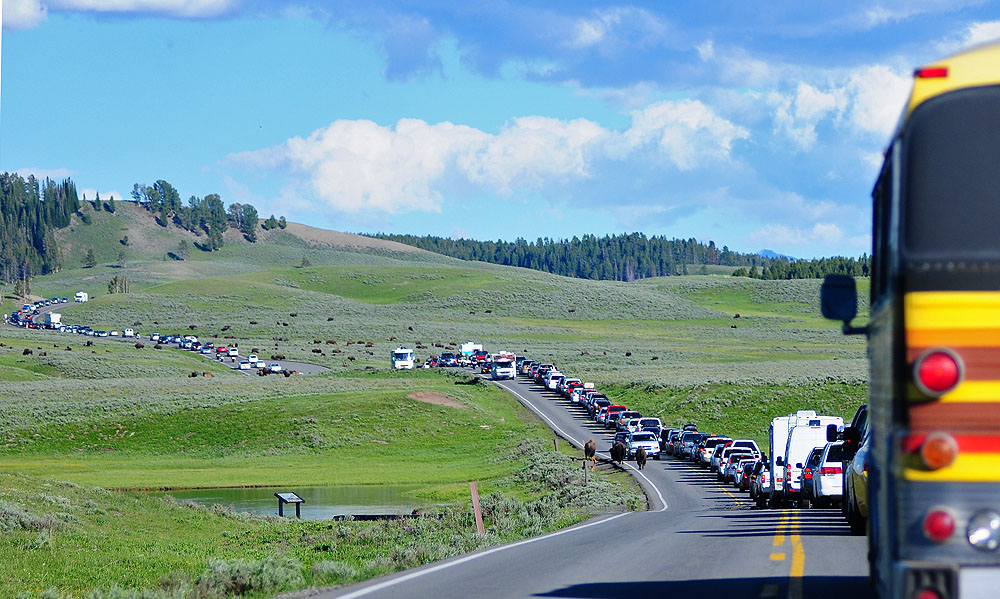
Bison in Yellowstone National Park cause a traffic jam on the road through Hayden Valley in this July 2010 file photo.
CODY, WYO. — Yellowstone National Park logged its first million-visitor month in July, a milestone symbolic of the heavy tourist traffic across the country’s national parks, as visitors travel to wide-open spaces in response to—and in spite of—the surging delta variant of COVID-19.
The National Park Service has yet to release final numbers, by Superintendent Cam Sholly told reporters last week that the park hosted approximately 1,080,000 recreational visitors in July, Yellowstone’s busiest month ever. Neighboring Grand Teton National Park also saw a record month in July, hosting an estimated 828,777 recreational visitors.
Record numbers of tourists are seeking to escape to the outdoors, as COVID outbreaks are surging in hotspots around the country. Warning of the potential for transmission of the virus in crowded visitor centers, the Park Service on Wednesday implemented a nationwide mask mandate for all parks.
Overall, local business owners are reporting a solid tourist season with reasonable margins. But the summer hasn’t been without significant difficulties for many operators.
The new mask mandate comes as gateway communities around Yellowstone and Grand Teton are struggling with a tight labor market and supply chain difficulties that are challenging lodging and restaurant industries still recovering from reduced demand, and months of mandated closures and reductions in capacity.
For crowded hotels and campgrounds, higher rates are helping offset increased operating costs. But restaurants, which don’t have the same pricing flexibility, are paying more for food and labor, with some turning to buffets in light of staffing shortages.
“Sit-down dining has been almost impossible to get off the ground here because of staffing challenges,” said Michael Keller, general manager in Yellowstone for Xanterra, the park’s primary concessioner, which operates hotels, restaurants and group tour activities.
Despite hiking wages mid-summer for cooks, laundry workers and campground supervisors, Xanterra still lacks enough staff at some key properties to offer traditional a la carte dining. Keller has turned to buffets and pre-made to-go options to help ease the workload and handle customer demands.
He said restaurant staffing shortages are a nationwide problem, along with food product shortages and shipping difficulties.
“We’ve had challenges all year getting basic staples like bacon, beef and produce,” Keller said.
After being required in 2020 by COVID restrictions to allocate much of Yellowstone’s visitor lodging for employees, Xanterra has closed only about 7 percent of its hotel rooms in the park to visitors this summer, Keller said.
QT’s Restaurant at the Holiday Inn in Cody, Wyo. has also converted to buffet dining for breakfast and dinner amid staffing shortages, said owner Ted Blair.
Blair said his labor costs have risen dramatically this summer, with some wages up as much as 25 percent, as housekeepers and other hospitality workers are commanding higher pay across the region.
“I think we’re doing OK with it,” he said. “Rates this year have gone up a bit and that’s the way we’re coping with it.”
Lodging rates across the greater Yellowstone area are up, with some properties, including the newly opened Hampton Inn in Cody, aiming to further reduce operating costs by requiring a two-night minimum stay.
But Blair said he is concerned that the spiking delta variant could again sideline travelers in typically busy late August and September.
Unlike last year, the Park Service is allowing tour buses in Yellowstone, although group tours are generally down from prior years.
The agency’s newly announced mask mandate requires visitors, employees and contractors to wear a mask inside all Park Service buildings, and in crowded outdoor spaces, regardless of vaccination status or community transmission levels.
The requirement also applies to outdoor spaces where physical distancing cannot be maintained, such as narrow or busy trails and overlooks, and will be in effect until further notice.
The mandate is sure to aggravate tensions at a time when tourism industry insiders report an ongoing trend of discourteous behavior by travelers in dining rooms, on airplanes and in public spaces across the country. Some managers have cited rude customers as one factor in labor shortages, as workers grow weary of conflicts over masks, physical distancing, crowds and higher prices.
Yellowstone spokeswoman Linda Veress said park managers are taking steps to help cope with the record crowds.
Entrance tickets and fishing permits can be bought online, and additional campgrounds are accepting online reservations, she said, moves that are already easing congestion in some places.
The park has also this summer launched an automated vehicle shuttle pilot program “with the intent to test this new technology, especially as visitation continues to increase,” she said.
Veress said that delivering a “a world-class visitor experience” is a strategic priority, and park managers are focusing on understanding and responding to how increased visitation affects natural resources, operations, infrastructure and other aspects traveling to Yellowstone and gateway communities.
Contact Ruffin Prevost at 307-213-9818 or ruffin@yellowstonegate.com.
